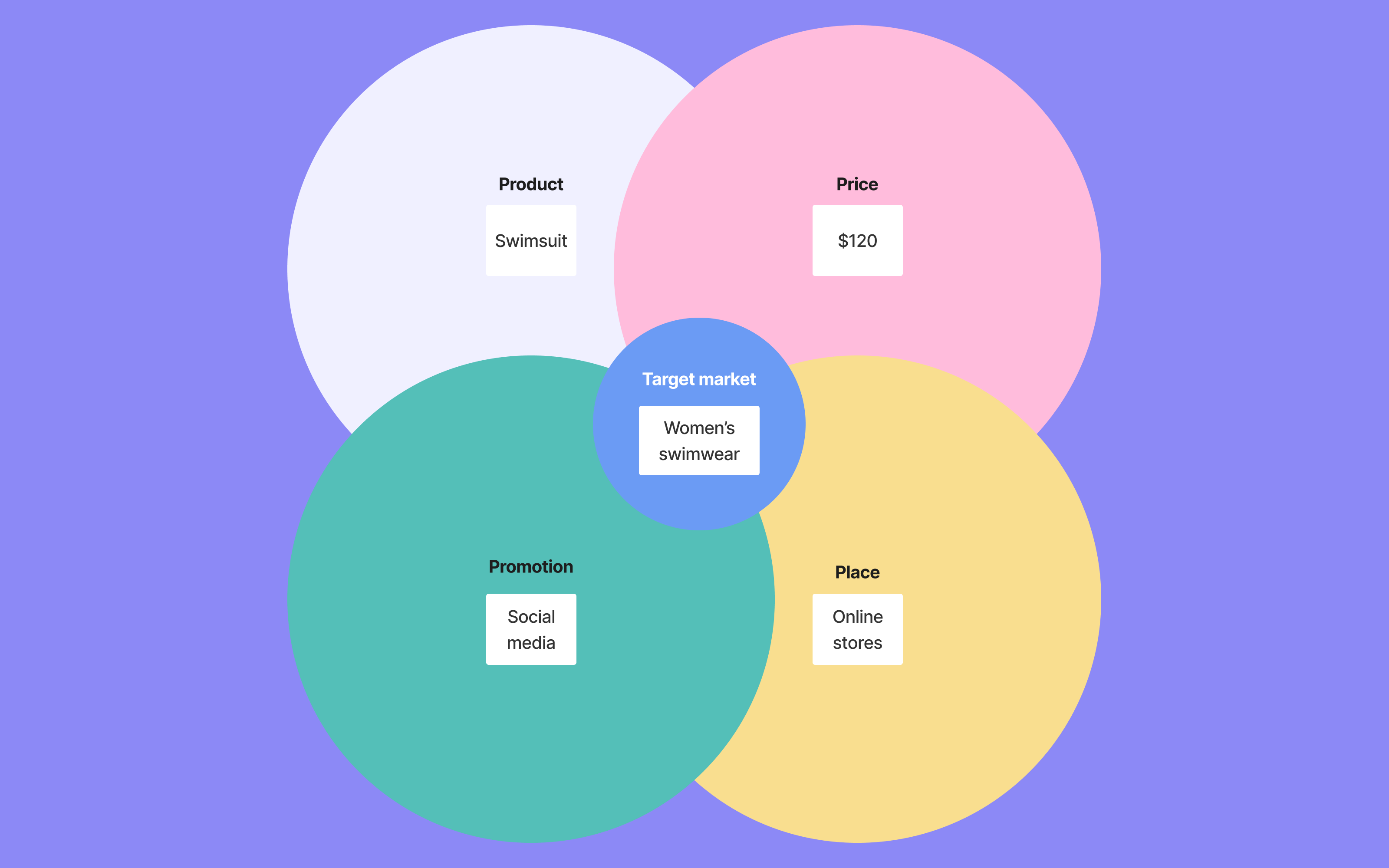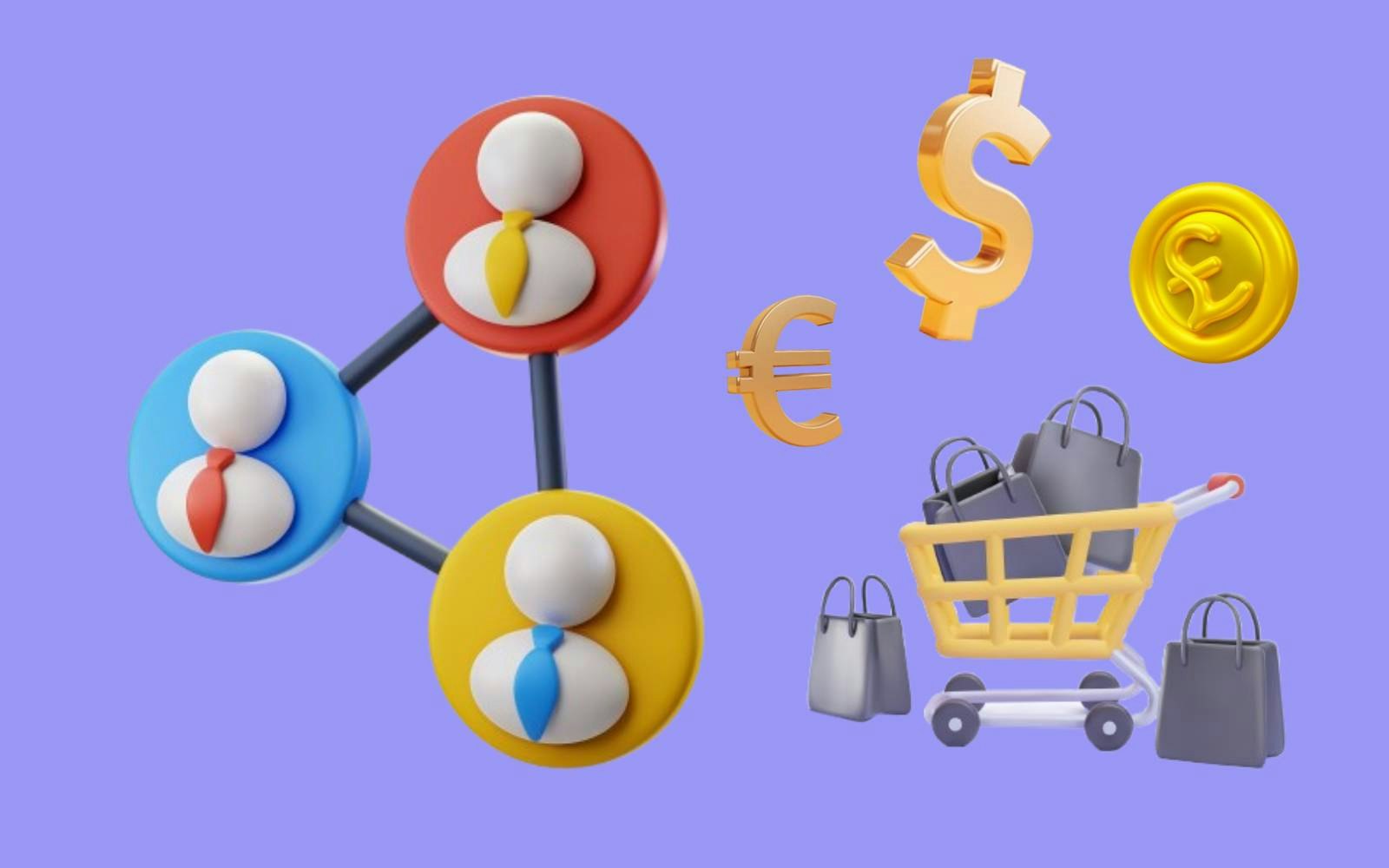The marketing mix, sometimes called the marketing plan, is an essential concept for businesses. Introduced in the 1960s by Jerome McCarthy and popularized by Philip Kotler, it refers to the acronym of the 4Ps: Product, Price, Place, Promotion.
This comprehensive method distinguishes businesses in a competitive market, allowing them to make informed decisions and adjust their marketing strategy to maximize their performance and achieve sales goals.
Definition of the marketing mix
The marketing mix provides an essential strategic framework, bringing together various marketing variables that businesses can adjust to achieve their sales goals with their target audience. This framework revolves around four central pillars: product, price, distribution, and communication, known as the 4Ps. These elements are inherently connected and must be finely tuned in synergy to develop an effective marketing strategy.
This strategic tool enables brands to make informed marketing decisions. The objective is to positively influence consumer purchasing behaviour while maximising profitability, by combining strategic and tactical levers.
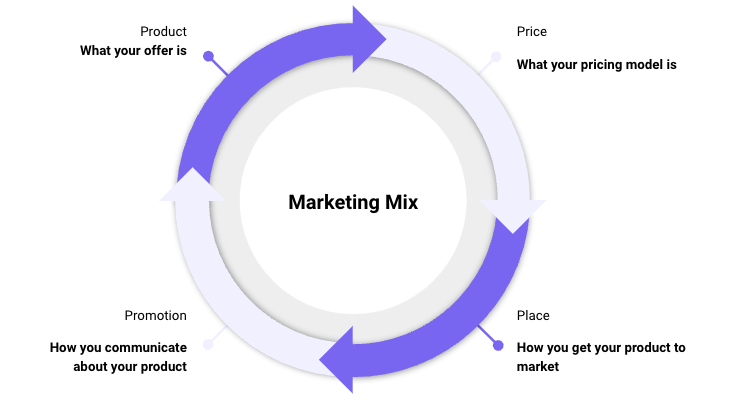
Marketing mix: definition of the 4Ps
This strategic tool allows brands to make smart marketing choices by combining these different components, with the goal of positively influencing consumer purchasing behaviors and maximizing profitability.
How to define your marketing mix?
The 4 components of the marketing mix must be consistent and complementary to each other. The entire approach must be designed to meet the needs of the target customers.
Below, we provide some tips for each of the "P"s in the marketing mix.
Defining your product offering
Understanding the motivations behind a customer's purchase of a product is essential when defining a product offering. It’s the perceived value that will ultimately guide their choice. Thus, marketing must brilliantly highlight the added value that your product brings to consumers.
Such an approach requires a perfect understanding of consumer needs, how your product meets them, and how the customer will use it. A product can go beyond being a simple material good to becoming an experience enhanced by additional services. Take the example of a computer sold with a warranty or technical support; this represents a synergy between a good and a service.
💡 To develop an optimal product offering, it is essential to consider its stage in the product life cycle, for two reasons:
The stage of the life cycle significantly impacts the marketing strategies applied. The promotion of a newly launched product must be more intense than that of a product already well-established in the market.
Distribution methods are also affected. For a new product, distribution is often more limited, gradually expanding through a broader distribution network as the product becomes known and appreciated by a wider audience.
The product range is also crucial in defining the offering. A product range can serve various goals:
attract consumers with competitively priced products;
generate profits with high-margin products;
facilitate customer transitions from one need to another within the product life cycle.
/quBy mastering these elements, you can design a product offering that not only meets consumer expectations but also aligns with the successive phases of the product life cycle, thus optimizing your marketing strategies.
Setting the selling price
Setting the selling price of your offering represents a central point in your business strategy. This determination must incorporate various key factors to ensure that the chosen price is both profitable and attractive to your target market.
To successfully set your selling price, it’s important to consider several factors:
Expected reaction from prospects/customers
It is crucial to understand the market's reaction dynamics to the price you plan to set. The goal is to determine the psychological price that people are willing to pay. You need to identify the price level at which potential customers are ready to commit and the minimum threshold to ensure that your offer’s quality is recognized. Likewise, it’s essential to set the cap beyond which your prospects will refuse to go.
Current pricing of the competition
The pricing strategies adopted by your competitors are another crucial aspect to consider. Analyzing public prices and current promotional actions from your competitors is essential.
If your offering turns out to be more expensive than the competition, you must explain this premium through a distinct competitive advantage. Whether through additional services, innovative features, or a significant added value in the eyes of your prospects, these elements will help solidify your market position.
Your costs and desired margins
A thorough examination of your costs, whether direct or indirect, fixed or variable, is essential. This step will help you understand the price level to adopt to achieve the desired margin.
Based on your analysis, several pricing approaches are possible: a penetration pricing strategy with attractive prices to capture the market, an alignment strategy aiming to match competitor prices, or a skimming strategy targeting a premium clientele with higher prices.

How you should price your product
Optimizing your distribution strategy
Selecting an appropriate distribution strategy is crucial in the marketing setup of a company, aiming to ensure not only the accessibility of its offer but also to maximize sales effectively.
Several key factors must be evaluated to achieve this goal.
Choosing the distribution network
It is essential to decide between a direct distribution channel or the use of intermediaries. For an indirect network, the number of intermediaries in the distribution chain must be precisely determined.
For example, direct distribution through a website or owned store yields a higher margin and full control over customer relations. In contrast, going through intermediaries like supermarkets or distributors, while potentially increasing reach and visibility, incurs additional costs.
Choosing distribution channels
The choice of distribution channel must align with consumer preferences and habits. Options include mass retail, retail sales, e-commerce, physical stores, and online marketplaces. Each channel has its own strengths and limitations.
E-commerce, for example, offers flexibility and significant global reach, while physical store sales allow for direct contact with customers and provide an enhanced brand experience.
Choosing intermediary actors
Intermediaries can take various forms, such as franchises, cooperatives, or large retailers. Each offers specific benefits and drawbacks. Franchises can contribute to a unified brand image and specialized expertise, while large retailers guarantee broader visibility but may present challenges regarding customer relationship management and product presentation.
In all cases, analyzing distribution costs is crucial. Logistics, storage, and marketing expenses must be carefully evaluated.
The selection of distribution channels must be based on a deep understanding of customer purchasing habits rather than on convenience or cost for the company. Adopting multiple channels can be wise if the business targets different customer segments, such as younger people favoring online shopping and adults preferring physical stores.
A multichannel distribution strategy increases the chances of success.
Promoting your product in the market
Valuing and promoting your product are key steps in your marketing strategy. They require formulating a strong value proposition and strategically communicating it through the appropriate channels.
Value proposition
The value proposition represents a distinctive promise highlighting the unique benefits provided by your product or service. It must be distinctive, explicit, and meet the needs and expectations of your clientele. Your Unique Selling Proposition should demonstrate how your product solves consumer problems, improves their condition, and offers superior quality or performance compared to competitors.
Selecting communication channels
Choosing the right communication channels is essential for effectively spreading your value proposition. This includes digital channels like social media, email campaigns, website content, and online ads—all effective means to reach a broad and specific audience.
At the same time, offline methods like marketing events, trade shows, print ads, and presence in retail stores offer direct interaction with customers, reinforcing trust and loyalty.
Multichannel communication strategy
The most effective approach is often a multichannel communication strategy, combining various platforms to engage your customers at different points in their buying journey. Social media can generate engagement and brand recognition, emails can foster loyalty, and in-store interactions can provide an immersive experience.
This strategy ensures maximum visibility and significant impact on your target audience.
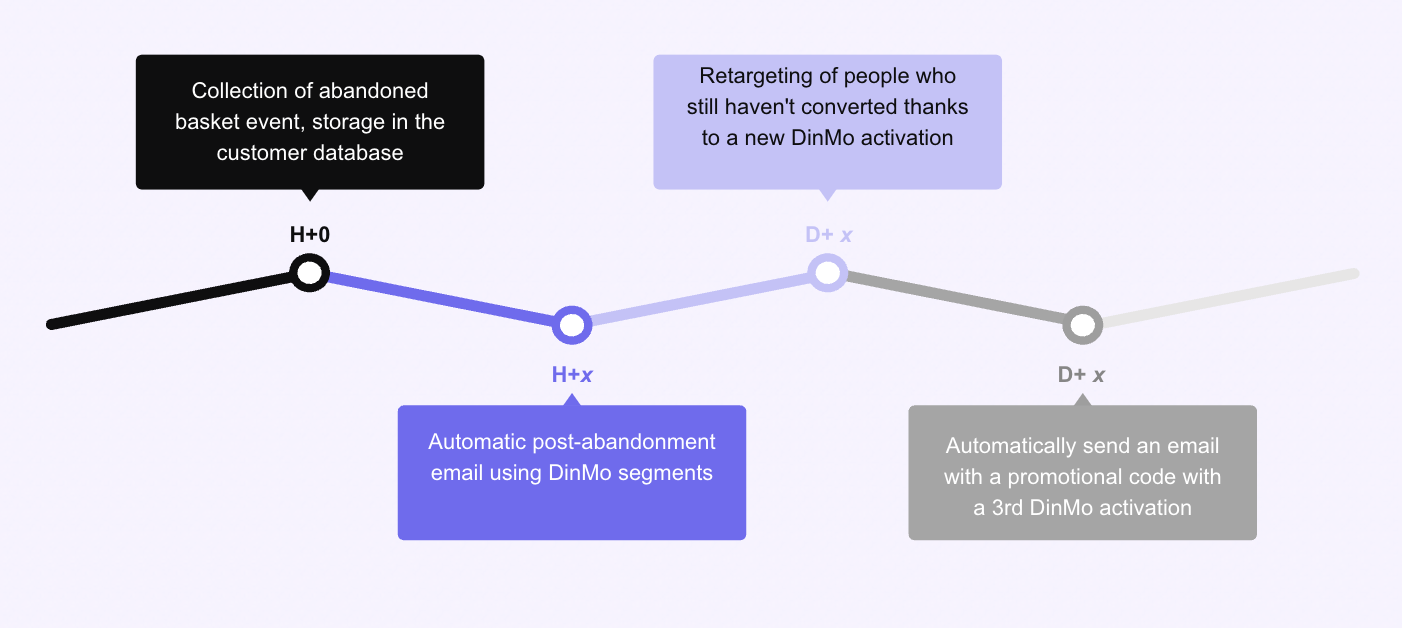
Illustration - Multicanal reactivation after cart abandonment
Evaluation and optimization
It is crucial to evaluate the effectiveness of your promotional efforts and adjust your strategy accordingly. This may involve analyzing performance metrics, collecting customer feedback, and conducting comparative tests to optimize your messages and distribution channels.
Toward an enriched marketing approach with the 7Ps
When discussing the marketing mix, the core pillars like product, price, promotion, and place are often the first to come up. However, a more holistic view invites us to consider three additional pillars, known as the 3 additional Ps. These components enrich the classic model and provide a more complete perspective on overall marketing strategy.
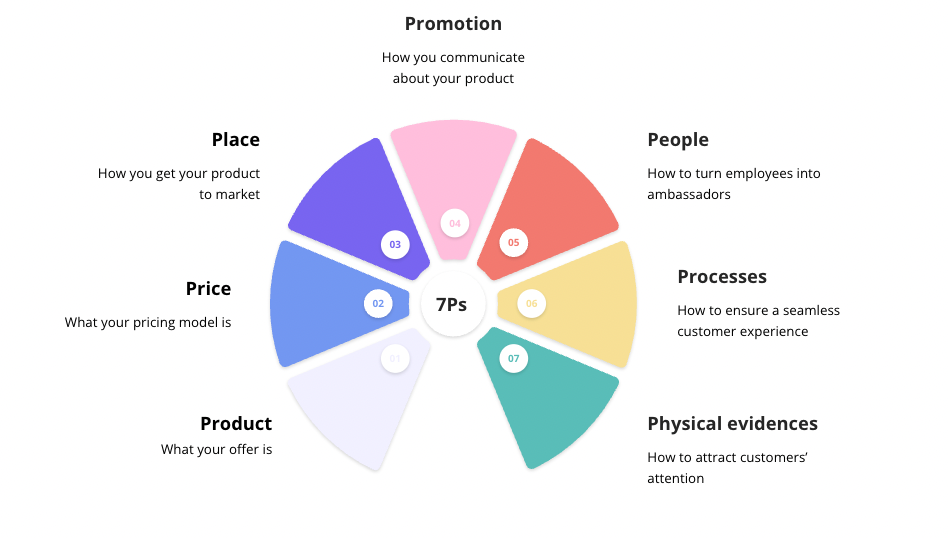
Marketing mix: definition of the 7Ps
People
Employees represent a key interface between the brand and consumers. They can become true brand ambassadors for your products or services. Their interaction with customers strongly influences the brand's image. Thus, high-quality customer service, supported by employee competence and engagement, is crucial for customer satisfaction and loyalty.
Processes
This key element of the 7P marketing mix focuses on optimizing the production and distribution of products or services. It includes logistical operations, supply chain management, and CRM systems, among other operational aspects.
Improving these processes is vital to ensuring a seamless customer experience, from order placement to delivery and even after-sales service.
Packaging (Physical Evidence)
Packaging is a powerful communication tool in a competitive market, attracting the attention of prospects and enhancing the perceived value for existing customers. More than just a container, the “packaging” (i.e., everything surrounding the product/service in a broad sense) symbolizes the brand image and is found across various touchpoints with the consumer: website, displays, employee uniforms, business cards, etc.
This tangible dimension plays a key role in establishing trust and customer loyalty. By incorporating these three additional components into the marketing mix, companies equip themselves with a more refined and efficient strategy, addressing all elements that shape the customer’s experience and brand perception.
Conclusion
In conclusion, combining the elements of the marketing mix is essential for developing a successful commercial strategy.
It’s crucial to define your product offering, set an attractive price, select an optimal distribution method, and promote your product with precision. By incorporating human aspects, processes, and packaging, you can create a comprehensive user experience. To implement these principles, tools like DinMo prove extremely beneficial.
DinMo, with its modular Customer Data Platform (CDP) solution, can support the application of each component of the marketing mix, particularly by synchronizing your data with your marketing tools and improving your segmentation and promotional campaigns.

















